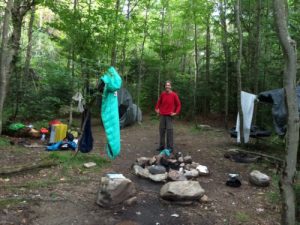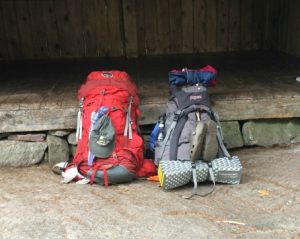
By our second day on the trail, Jan and I recognized the importance of developing routines; by the end of our hike, we were discussing ways to implement similar routines at home.
ON THE TRAIL
With more backcountry experience than me, Jan had more camping routines down, and I learned a lot from her, from how to wash dishes with a minimum of soap and water, to how to stay relatively clean and comfortable myself. But other efficiencies, like getting out in a reasonable time, we learned as we walked.
Because I woke first, I started heating water for coffee; because Jan was recovering from plantar fasciitis, she stretched and exercised her feet. But things became more complicated after that. For instance, I’d find myself still wearing the zip-on legs of my hiking pants after I’d tied on my hiking shoes, meaning I had to take the shoes off, unzip the legs, unpack my clothing sack, repack, retie, and resume the process of getting on the trail. In the beginning, it took us up to three hours from waking to hiking. By the end of the trip, we could wake, stretch, breakfast, plot our short-term distance goals, plan lunch and snacks, break camp and get going in an hour and a half.
We were able to achieve this time-efficiency by creating a mental checklist.
We also took turns telling stories as we hiked. On Day Two, I told Jan about The Checklist an article by Atul Gawande I’d read in The New Yorker. Gawande writes about how simple checklists have improved complex medical care.
Packing a limited number of items into a backpack and resuming a long hike is not medical science. Nevertheless, checklists helped us develop efficiencies that made the tasks of making and breaking camp easier, faster, and more comfortable. Developing a checklist for setting up, cooking on, and breaking down our camp stove may have also saved us from burning dinner, the forest, and ourselves.
As Gawunde explains, checklists aid memory recall. As sixty-year olds, we could have spent as much time looking for the lighter we used to ignite the stove as we do looking for our keys in off-trail life, but by developing routines – always replacing the lighter in the stove bag – this didn’t happen even once.
Other routines made for small efficiencies throughout the trip and each day. Every six days after picking up our next week’s food, we struggled under the increased weight of our packs. We quickly learned to eat the meals that weighed the most first. Each morning, we placed the day’s snacks at the top of Jan’s pack, and the day’s lunch at the top of mine, so that we didn’t have to search for them while we were on the trail.
As soon as we arrived at our night’s shelter, we unrolled our sleep sacks, fetched water, and sponged off the day’s sweat before donning our camp clothes. Efficiencies aside, this made us feel good.
AT HOME
As days turned into weeks, we started talking about how all the lessons from the trail would translate into life back at home. Jan’s a retired attorney who for years reported to work every day; I’m self-employed and have more experience in planning my days.
A second effect of using a checklist, according to Gawunde, is to make explicit the minimum, necessary steps in a complex process, like planning a day during which one meets all her needs of self-care, work, and social- and civic-engagement. We agreed we wanted to schedule our days to be satisfying beyond simply getting things done.
MY ROUTINE
Despite my years of experience, I still struggle with creating the perfect day, well, daily. Since returning from the trail, however, I’ve become clearer about what I need to do, beginning with morning meditation.
For years, I’ve started with a writing practice. This year, I’ve begun a sitting practice as well, which I now do before writing. I developed Patella-femoral syndrome on the trail, so I’ve added some physical therapy exercises; now that my knees are better, I follow writing practice with gentle yoga. By the time I’ve finished all this, Tim has brewed coffee, cared for the field birds, and shaved. We breakfast together, then go to work.
Work is easy: write. Long-term, long-form projects first; short-form essays and posts follow.
Daily exercise: either a walk with Leo after lunch (some days, a friend joins us) and yoga a few late afternoons.
Two new behaviors that have come home from the trail with me include 1) turning off the computer before dinner, and 2) planning the next day, especially what I’m going to work on, before reading and sleep.
Of course, not all days run smoothly. Even on the trail, we had to change course. I’ll tell that story next week.

You can receive next week’s post by email by subscribing. Just enter your address in the box, click subscribe and check your email to confirm that you’re a reader and not a robot.
I’m really enjoying these
Thanks for letting me know!
Love this, especially the morning routine.
The morning routine is making a huge difference in how my day goes. Everything else seems to fall into place – most of the time.
Great lessons you are sharing.
Day six of retirement has me baffled as to how I got so much done while working and raising 3 kids.
An entire week just flew by and dashed all the dreams of all the things I would have done by now.
I love the meditation and yoga to start the day and breakfast with Tim!
What a great start to the day, the breakfast connection.
One of the lessons that comes through from each piece you write, is taking the time to plan so time is not wasted later. Also the good old saying from Mother, “a place for everything, and everything in its place” (as I search for the car keys I was so sure I put in my pants pocket yesterday)
Turning off the computer before supper is brilliant! Does it stay off then for the night?
I am going to try to incorporate some of your lessons into my new life , Thanks! Just what I needed to learn.
Jan, my hiking buddy, is both recently retired and newly divorced, so we talked a lot about ways I’ve learned as a self-employed loner who has had to learn how to organize each day since the beginning of time. She’s now unhooked from work-life, living alone and very, very busy.
From my own experience, I can say with certainty that it’s a constant series of discoveries, trials, errors, and – above all – constant planning and flexibility.
Thanks for writing – and good luck!
Andi,
Congrats on your retirement! When I first retired I took guilty pleasure in being able to do whatever I wanted, even if some of it was rather frivolous. I think it’s good to allow this to happen. At the same time, I too wondered how I got so much done pre-retirement, and post-retirement I would keep a rough list (on my outlook calendar) of things I did each day. This was probably a mix of old habits (lawyers need to keep track of their billable time) and a reminder that I really was accomplishing things amidst the equally important play time. Have fun and good luck in achieving this balance of planning and flexibility, work and play.
Jan (Deb’s hiking buddy)